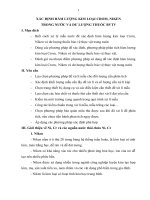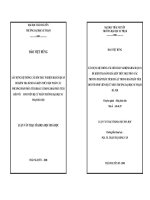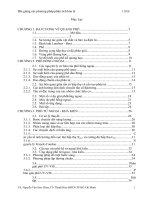Dai cuong cac pp phan tich hoa ly
Bạn đang xem bản rút gọn của tài liệu. Xem và tải ngay bản đầy đủ của tài liệu tại đây (558.81 KB, 10 trang )
INSTRUMENTAL ANALYSIS
VT 2013
(C) HKD 2013
CLASSICAL ANALYTICAL METHODS
Wet-chemical methods
Separation of component of interest (analyte) from the sample by
precipitation, extraction, or distillation.
Followed by gravimetric or titrimetric measurement for quantitative
analysis.
(C) HKD 2013
INSTRUMENTAL ANALYSIS
(C) HKD 2013
INSTRUMENTAL ANALYSIS
Instrument converts information stored in the physical or chemical
characteristics of the analyte into useful information.
Require a source of energy to stimulate measurable response from
analyte.
Data domains
9 Methods of encoding information electrically.
9 Nonelectrical domains.
9 Electrical domains.
9 Analog, Time, Digital.
(C) HKD 2013
INSTRUMENTAL ANALYSIS
Detector
9 Device that indicates a change in one variable in its environment (eg.,
pressure, temp, particles).
9 Can be mechanical, electrical, or chemical.
Sensor
9 Analytical device capable of monitoring specific chemical species
continuously and reversibly.
Transducer
9 Devices that convert information in nonelectrical domains to electrical
domains and the converse.
(C) HKD 2013
METHOD SELECTION
What accuracy is required.
How much sample is available.
What is the concentration range of the analyte.
What components of the sample will cause interference.
What are the physical and chemical properties of the sample matrix.
How many samples are to be analyzed.
(C) HKD 2013
ACCURACY vs PRECISION
Accuracy
9 Describes the correctness of an experimental result.
9 Absolute error.
9 Relative error.
Precision
9 Describes the reproducibility of results.
9 Standard deviation.
9 Variance.
9 Coefficient of variation.
9 Relative standard deviation.
(C) HKD 2013
ACCURACY vs PRECISION
(C) HKD 2013
SENSITIVITY
Sensitivity of an instrument or method is its ability to discriminate between
small differences in analyte concentration.
S = mc + Sbl
S = measured signal; c= analyte concentration;
Sbl = blank signal; m = sensitivity (Slope of line).
Analytical sensitivity (J)
J = m/ss
m = slope of the calibration curve
ss = standard deviation of the measurement
2 factors limit sensitivity
9 Slope of calibration curve.
9 Precision of measuring device.
(C) HKD 2013
CALIBRATION CURVE
(C) HKD 2013
CALIBRATION CURVE
Least-square regression line
Y = b0 + b1X
(C) HKD 2013
CALIBRATION CURVE
External Standard Method
(C) HKD 2013
CALIBRATION CURVE
Internal Standard Method
(C) HKD 2013
CALIBRATION CURVE
Standard Addition Method
(C) HKD 2013
DETECTION LIMIT
Detection limit: the minimum concentration or mass of analyte that can be
detected at a known confidence level. LOD is determined by S/N, where, S/N =
Signal-to-noise ratio = (magnitude of the signal)/(magnitude of the noise).
Cm = (Sm – Sbl)/m, where, Cm = minimum concentration i.e., LOD, Sm =
minimum distinguishable analytical signal (i.e., S/N = 2 or S/N = 3), Sbl = mean
blank signal
(C) HKD 2013
LINEARITY
Linear range: extends from the lowest concentration at which quantitative
measurements can be made (LOQ), to the concentration at which the
calibration curve departs from linearity (LOL).
(C) HKD 2013
INSTRUMENTAL METHODS
Chromatographic methods
9 Gas chromatography.
9 Liquid chromatography.
Spectrophotometric methods
9 Absorption: Atomic absorption, Molecular absorption (UV-Vis, IR).
9 Inductively coupled plasma.
Spectroscopic methods
9 Mass-spectrometry.
9 Nuclear Magnetic Resonance spectrometry.
(C) HKD 2013
APPLICATIONS
Bioanalytical: biological molecules and/or biological matrices (e.g., proteins,
amino acids, blood, urine)
Environmental: pesticides, pollution, air, water, soil
Material science: polymers, characterization of new materials
Forensic science (application of science to the law): body fluids, DNA, gun
shot residue, hair, fibers, elemental analysis, drugs, alcohols, poisoning,
fingerprints, etc.
(C) HKD 2013
METHODOLOGY
Plan: Qualitative or quantitative or both; what kind of information have; which
technique is suitable etc.
Sampling: Accuracy depends on proper sampling, characteristic of sample is
very important, required good representative sample (from top, middle and
bottom and mix up and take average sample).
Sample preparation: depends on analytical techniques.
Analytical measurement
Data Analysis: Whether the data make sense or not.
(C) HKD 2013









